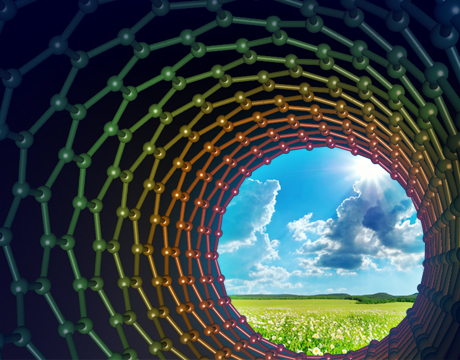Making Carbon Nanotubes Safer for the Environment
Making Carbon Nanotubes Safer for the Environment


Even though carbon nanotubes (CNTs) have become a key ingredient in advanced manufacturing processes, surprisingly little is known about how they actually form. The most common method for manufacturing CNTs is through chemical vapor deposition (CVD) of ethylene. This approach, however, results in a complex mixture of volatile organic compounds and polycyclic aromatic hydrocarbons. Some of these are likely important to the CNT formation process and others are byproducts that may actually interfere with the formation of CNTs, creating structural defects and degrading overall quality. Some of these byproducts are also harmful to human health and the environment, including contributing to greenhouse gas emissions.
Not knowing exactly how CNTs form also makes it harder to improve on carbon conversion and energy efficiency during the manufacturing process; this lack of knowledge also limits how CNTs can be used in product design.
To learn more about the formation mechanism of CNTs via CVD, Desire´e L. Plata, a civil and environmental engineering professor at Duke University, designed a research experiment to determine how chemical bonds are built during nanotube synthesis, with the goal of improving the manufacturability of CNTs and minimizing the environmental impacts of this technology. Her study was published in 2010 in the American Chemical Society’s online journal ACSNano.
Exciting Results
“In general, CNT growth by CVD involves introducing a gaseous carbon precursor, such as methane, into a heated (1300 °C) reaction zone that contains a free-floating or substrate-supported catalyst,” says Plata. “The catalyst is typically a transition metal or oxide nanoparticle that is thought to mediate the reaction. While the current understanding is limited with respect to chemical details, the prevailing notion is that the carbon-containing precursor adsorbs onto and then dissociates at the catalyst.”
To simulate the effect of this thermal treatment without the chemical complexities, Plata delivered trace amounts of individual hydrocarbons, along with ethylene and hydrogen, to a cold-wall atmospheric pressure reactor containing a locally heated metal catalyst (Fe on Al2O3). Using these compound-specific experiments, Plata was able to show that many alkynes (including acetylene, methyl acetylene, and vinyl acetylene) accelerated multi-walled CNT formation. The results also demonstrated that the presence of ethylene enhances CNT growth, suggesting that alkynes and ethylene may react at the metal catalyst.
“This presents a distinct CNT formation mechanism where the chemical precursors may be intact during C-C bond formation, such as in polymerization reactions, challenging the current idea that precursors completely dissociate into C (or C2) units before precipitating from the metal,” she states.
Using this methodology Plata was able to quickly form high-purity CNTs with a 15-fold improvement in yield, a 50-percent reduction in energetic costs, and an order of magnitude reduction in the volume of hazardous byproduct formation (toxic and smog-forming chemicals and greenhouse gases).
Future Possibilities
Plata’s research supports the following conclusions:
- Alkynes contribute to accelerated CNT formation while other previously suspected molecules such as benzene and methane do not.
- If alkyne-assisted techniques are fully optimized for high-volume synthesis, dramatic improvements in CNT yield and mass-per-hour production rates can be realized.
- Reduced byproduct emissions can prevent unnecessary damage to the environment and public health as industrial CNT production continues to expand.
- Because carbon precursors are intact when they incorporate into a growing CNT, their structures can be used to influence the morphology of the CNTs
- Hydrogen can be a tunable parameter to control tube length and quality.
Plata is confident that engineers will discover the carbon nanotube growth mechanism in the next five years. “This will be an amazing accomplishment because it will make renewable energy sources a truly competitive reality by improving their energy storage and distributions systems,” she says. “These systems will require novel materials and the best candidates are carbon-based nanomaterials such as CNTs.”
She also points out that her research highlights an advantage of mechanical engineer-environmental engineer teamwork—“by knowing more about the process on a molecular level, its performance and cost can be optimized in a more expeditious way than it could without the environmental analysis,” Plata says. “Also, early incorporation of environmental objectives will actually enhance the lifetime of the process because it won't be banned or regulated if some malignant impact is discovered after it is commercialized.”
Mark Crawford is an independent writer.
High-purity carbon nanotubes were produced with a 15-fold improvement in yield, a 50-percent reduction in energetic costs, and an order of magnitude reduction in the volume of hazardous byproduct formation.Desire´e L. Plata, Duke University



